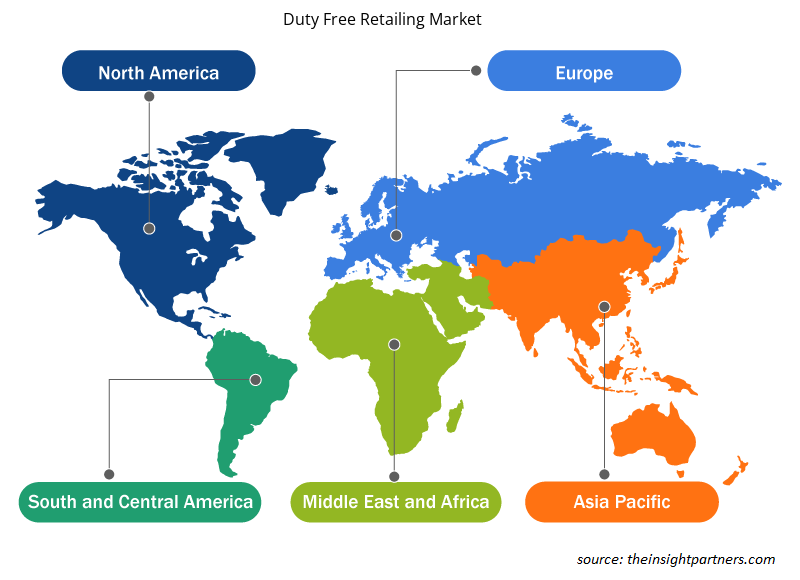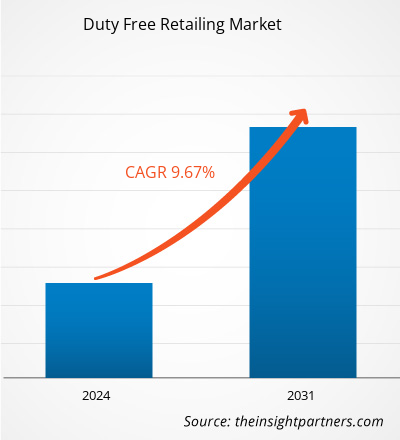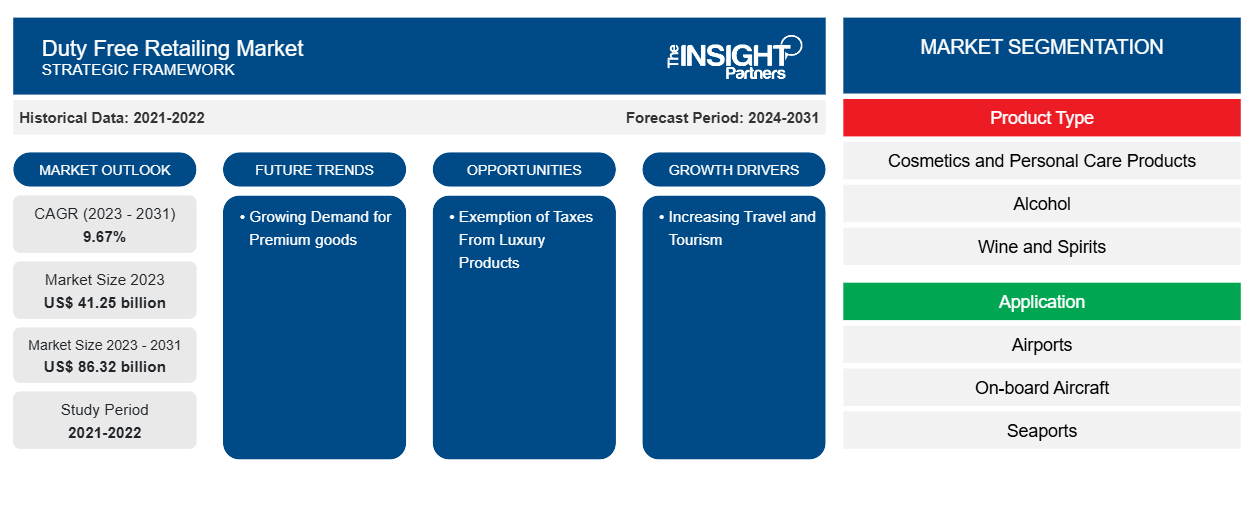Se proyecta que el tamaño del mercado minorista libre de impuestos alcance los 86.320 millones de dólares estadounidenses para 2031, frente a los 41.250 millones de dólares estadounidenses en 2023. Se espera que el mercado minorista libre de impuestos registre una CAGR del 9,67 % entre 2023 y 2031. El declive cada vez mayor de los productos de lujo y las compras en un solo lugar.
Análisis del mercado minorista de productos libres de impuestos
La creciente inversión y el desarrollo de la industria de viajes y turismo, junto con la integración de segmentos que incluyen hospitalidad e infraestructura con el apoyo del gobierno para mejorar la industria de viajes y turismo , dan como resultado el crecimiento del mercado minorista libre de impuestos.
Panorama general del mercado minorista de productos libres de impuestos
El concepto de tiendas libres de impuestos hace referencia a los puntos de venta que venden productos exentos del pago de determinados impuestos nacionales y locales; esta exención fiscal reduce los precios en comparación con las tiendas minoristas tradicionales. Las tiendas libres de impuestos permiten a los viajeros ahorrar dinero en diversos productos, como licores, perfumes, tabaco, cosméticos, productos electrónicos y más. Los ahorros pueden ser significativos, especialmente en el caso de artículos de lujo de alto precio. Estas tiendas libres de impuestos están ubicadas estratégicamente dentro de las terminales de los aeropuertos internacionales, lo que las hace fácilmente accesibles para los viajeros que salen o llegan de otros países. Por lo tanto, si los pasajeros necesitan comprar artículos que puedan necesitar durante su viaje o comprar recuerdos y regalos para amigos y familiares, pueden hacerlo fácilmente en estas tiendas libres de impuestos.
Personalice este informe según sus necesidades
Obtendrá personalización en cualquier informe, sin cargo, incluidas partes de este informe o análisis a nivel de país, paquete de datos de Excel, así como también grandes ofertas y descuentos para empresas emergentes y universidades.
-
Obtenga las principales tendencias clave del mercado de este informe.Esta muestra GRATUITA incluirá análisis de datos, desde tendencias del mercado hasta estimaciones y pronósticos.
Factores impulsores y oportunidades del mercado minorista libre de impuestos
Exención de impuestos a productos de lujo para favorecer el mercado
Los artículos libres de impuestos permiten a los consumidores comprar artículos de lujo y de alta gama a precios libres de impuestos. Con estilos de vida ajetreados, los consumidores prefieren hacer compras en un solo lugar, y este tipo de venta minorista libre de impuestos les ayuda a comprar mejores productos de lujo. Los artículos de lujo como perfumes, relojes, puros, alcohol de primera calidad, bisutería y otros son los artículos más atractivos en las tiendas libres de impuestos a precios más económicos, lo que atrae a los consumidores. Además, varios países están abriendo puntos de venta minoristas de lujo libres de impuestos. Por ejemplo, en noviembre de 2021, Louis Vuitton, una tienda de artículos de lujo libres de impuestos, abrió en el centro de la isla de lujo de Hainan. Por lo tanto, esta inclinación hacia los productos de lujo libres de impuestos impulsa el crecimiento del mercado minorista libre de impuestos.
Aumento de los viajes y el turismo
Según el primer Barómetro del Turismo Mundial de la Organización Mundial del Comercio (OMT) de las Naciones Unidas, el turismo internacional cerró 2023 con un 88%, con un estimado de 1.300 millones de llegadas internacionales. El último Barómetro del Turismo Mundial de la OMT ofrece un panorama completo del desempeño del sector en 2023, haciendo un seguimiento de la recuperación por región, subregión y destino global. Los ingresos por turismo internacional alcanzaron los 1,4 billones de dólares de los EE.UU. en 2023, según estimaciones preliminares. Además, se estima que el turismo emisor y receptor chino se acelerará en 2024 debido a la facilitación de visados y la mejora de la capacidad aérea. China está solicitando viajes sin visa para ciudadanos de Francia, Italia, Alemania, Países Bajos, España y Malasia durante un año hasta el 30 de noviembre de 2024. Se prevé que Europa vuelva a impulsar los resultados en 2024. En marzo, Rumania y Bulgaria se unieron al espacio Schengen de libre circulación, y París albergará los Juegos Olímpicos de verano en julio y agosto de 2024. Estos favores al aumento de los viajes y el turismo aumentarán los viajes internacionales, lo que creará oportunidades para el crecimiento del mercado minorista libre de impuestos.
Análisis de segmentación del informe del mercado minorista de productos libres de impuestos
Los segmentos clave que contribuyeron a la derivación del análisis del mercado minorista libre de impuestos son el tipo de producto y la aplicación.
- Según el tipo de producto, el mercado minorista libre de impuestos se segmenta en cosméticos y productos de cuidado personal, alcohol, vino y bebidas espirituosas, tabaco y cigarrillos, moda, confitería y alimentos, y otros.
- Según la aplicación, el mercado minorista de productos libres de impuestos se segmenta en aeropuertos, a bordo de aeronaves, puertos marítimos y otros.
Análisis de la cuota de mercado de venta minorista libre de impuestos por geografía
El alcance geográfico del informe del mercado minorista de artículos libres de impuestos se divide principalmente en cinco regiones: América del Norte, Asia Pacífico, Europa, Oriente Medio y África, y América del Sur/América del Sur y Central. El comercio minorista de artículos libres de impuestos a nivel mundial con el aumento de los viajes y el turismo y el crecimiento de la infraestructura aeroportuaria. En agosto de 2023, el Consejo Internacional de Aeropuertos (ACI) World pronosticó un crecimiento anual promedio del 5,8% en el tráfico de pasajeros entre 2022 y 2040. Para 2040, más de 19 mil millones de pasajeros viajarán a través de los aeropuertos del mundo cada año. En noviembre de 2023, el Consejo Internacional de Aeropuertos informó que la región de Asia y el Pacífico tiene un potencial significativo para la aviación, ya que el 57% de los 300 aeropuertos planificados a nivel mundial se están construyendo en esta región. Por lo tanto, dicho crecimiento en los aeropuertos y el tráfico de pasajeros crea una oportunidad lucrativa para el crecimiento del mercado minorista de artículos libres de impuestos.
Perspectivas regionales del mercado minorista de productos libres de impuestos
Los analistas de Insight Partners explicaron en detalle las tendencias y los factores regionales que influyen en el mercado minorista de productos libres de impuestos durante el período de pronóstico. Esta sección también analiza los segmentos y la geografía del mercado minorista de productos libres de impuestos en América del Norte, Europa, Asia Pacífico, Oriente Medio y África, y América del Sur y Central.

- Obtenga los datos regionales específicos para el mercado minorista libre de impuestos
Alcance del informe sobre el mercado minorista de productos libres de impuestos
| Atributo del informe | Detalles |
|---|---|
| Tamaño del mercado en 2023 | US$ 41.25 mil millones |
| Tamaño del mercado en 2031 | US$ 86.32 mil millones |
| CAGR global (2023 - 2031) | 9,67% |
| Datos históricos | 2021-2022 |
| Período de pronóstico | 2024-2031 |
| Segmentos cubiertos |
Por tipo de producto
|
| Regiones y países cubiertos |
América del norte
|
| Líderes del mercado y perfiles de empresas clave |
|
Densidad de actores del mercado minorista de productos libres de impuestos: comprensión de su impacto en la dinámica empresarial
El mercado minorista de productos libres de impuestos está creciendo rápidamente, impulsado por la creciente demanda de los usuarios finales debido a factores como la evolución de las preferencias de los consumidores, los avances tecnológicos y una mayor conciencia de los beneficios del producto. A medida que aumenta la demanda, las empresas amplían sus ofertas, innovan para satisfacer las necesidades de los consumidores y aprovechan las tendencias emergentes, lo que impulsa aún más el crecimiento del mercado.
La densidad de actores del mercado se refiere a la distribución de las empresas o firmas que operan dentro de un mercado o industria en particular. Indica cuántos competidores (actores del mercado) están presentes en un espacio de mercado determinado en relación con su tamaño o valor total de mercado.
Las principales empresas que operan en el mercado minorista de Duty Free son:
- Aeropuerto Internacional Aer Rianta (ARI)
- Grupo Libre de Impuestos de China Co., Ltd.
- Tiendas libres de impuestos en Dubái
- Tiendas libres de impuestos en las Américas
- Gebr. Heinemann
- Grupo Internacional King Power
Descargo de responsabilidad : Las empresas enumeradas anteriormente no están clasificadas en ningún orden particular.

- Obtenga una descripción general de los principales actores clave del mercado minorista libre de impuestos
Noticias y desarrollos recientes del mercado minorista de artículos libres de impuestos
El mercado de venta minorista libre de impuestos se evalúa mediante la recopilación de datos cualitativos y cuantitativos a partir de una investigación primaria y secundaria, que incluye publicaciones corporativas importantes, datos de asociaciones y bases de datos. A continuación, se incluye una lista de los avances del mercado:
- En marzo de 2024, Mumbai Travel Retail Private Limited (MTRPL) anunció su cambio de marca a OSPREE. La nueva identidad de marca "Ospree" sirve como estrategia de MTRPL para integrar todas sus tiendas libres de impuestos, incluidas Mumbai, Amritsar, Lucknow, Thiruvananthapuram, Jaipur, Ahmedabad y Mangalore.
(Fuente: Mumbai Travel Retail Private Limited, comunicado de prensa, 2024)
- En enero de 2024, Mumbai Duty Free anunció la apertura de una tienda Nappa Dori en la zona de salidas del Aeropuerto Internacional Chhatrapati Shivaji Maharaj, lo que marca la entrada de la marca en el sector de la venta minorista de viajes. Nappa Dori, que se traduce como cuero e hilo, es una marca de origen indio famosa por sus artículos y accesorios de cuero hechos a mano.
(Fuente: Mumbai Duty Free, comunicado de prensa, 2024)
Informe sobre el mercado de venta minorista libre de impuestos: cobertura y resultados
El informe "Tamaño y pronóstico del mercado minorista libre de impuestos (2021-2031)" proporciona un análisis detallado del mercado que cubre las siguientes áreas:
- Tamaño del mercado y pronóstico a nivel global, regional y nacional para todos los segmentos clave del mercado cubiertos bajo el alcance
- Dinámica del mercado, como impulsores, restricciones y oportunidades clave
- Principales tendencias futuras
- Análisis detallado de las cinco fuerzas de Porter y PEST y FODA
- Análisis del mercado global y regional que cubre las tendencias clave del mercado, los principales actores, las regulaciones y los desarrollos recientes del mercado.
- Análisis del panorama de la industria y de la competencia que abarca la concentración del mercado, el análisis de mapas de calor, los actores destacados y los desarrollos recientes
- Perfiles detallados de empresas
- Análisis histórico (2 años), año base, pronóstico (7 años) con CAGR
- Análisis PEST y FODA
- Tamaño del mercado, valor/volumen: global, regional y nacional
- Industria y panorama competitivo
- Conjunto de datos de Excel
Informes recientes
Testimonios
Razón para comprar
- Toma de decisiones informada
- Comprensión de la dinámica del mercado
- Análisis competitivo
- Información sobre clientes
- Pronósticos del mercado
- Mitigación de riesgos
- Planificación estratégica
- Justificación de la inversión
- Identificación de mercados emergentes
- Mejora de las estrategias de marketing
- Impulso de la eficiencia operativa
- Alineación con las tendencias regulatorias























 Obtenga una muestra gratuita para - Mercado minorista libre de impuestos
Obtenga una muestra gratuita para - Mercado minorista libre de impuestos